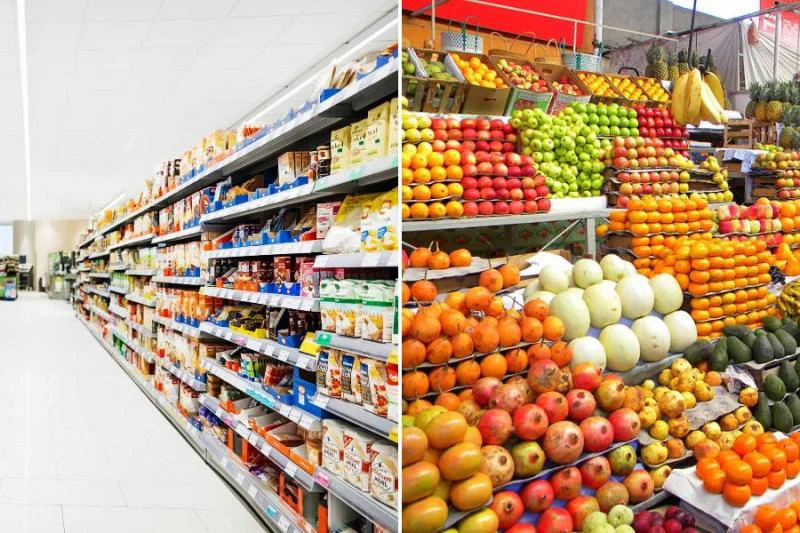The main difference between an open market and a supermarket is how they are set up, how you shop there, and what kinds of things they sell. Open markets, also called farmers’ markets or street markets, are places where people sell their goods outside. They often have fresh, locally grown food, handmade crafts, and artisanal goods. Open markets are more traditional and community-based places to shop. In contrast, supermarkets are large, indoor, self-service stores that sell a wide range of goods, including groceries, household items, and personal care products, often from different brands and suppliers. Supermarkets offer a more modern and convenient way to shop, with standardised prices and more products.
What is an Open Market?
An open market, also called a farmers’ market or street market, is where people and small businesses sell their goods directly to customers in the open air. Fruits, vegetables, meats, and dairy products that are fresh and grown locally are often the main focus of these markets. Handmade crafts, artisanal foods, and other unique items may also be sold there.
Most of the time, local businesses and the local economy do better when there are open markets. Open markets offer a traditional, community-based way to shop that encourages customers and sellers to talk to each other directly. They give shoppers a chance to discover where the products come from, how they are made, and who makes them.
In addition to the social and economic benefits, open markets often focus on seasonality and sustainability. This encourages people to eat fresh, in-season produce and reduces the carbon footprint of transportation and storage.
In short, an open market is a place to shop outside that focuses on local, seasonal, and artisanal goods, where customers and sellers can talk to each other directly, and that helps small businesses and the local economy. It’s a traditional, community-based way to shop that focuses on sustainability and helps people feel connected.
What is a Supermarket?
A supermarket is a large, self-service store that sells a wide range of goods, such as groceries, household items, personal care products, and sometimes clothing and electronics. Supermarkets have a wide range of products, set prices, and make it easy to shop, so they can meet their customers’ different needs and tastes.
Most supermarkets have well-organised aisles and departments, such as produce, dairy, meat, bakery, and frozen foods. This makes it easy for shoppers to get around and find what they need. Many supermarkets offer extra services like deli counters, pharmacies, and in-store banking to make things easier for customers.
Supermarkets get their goods from many different suppliers and brands. They often sell national and store brands, giving customers a wide range of quality and price options. They often use sales, discounts, and loyalty programmes to bring in new customers and keep the ones they already have.
In short, a supermarket is a large, self-service store with a wide range of products, making shopping easy. It offers a wide variety of products and services to meet the demands of a wide range of clients and is distinguished by its uniform pricing structure and well-organised layout.
Difference Between Open Market and Supermarket
Open markets and supermarkets fundamentally differ in layout, customer service, selection, and origin of goods.
Structure
In open markets, sellers set up temporary stalls or stands outside to offer their wares directly to customers. Supermarkets are indoor megastores with clearly demarcated sections and aisles for shoppers to navigate.
Shopping Experience
Customers at open markets can build rapport with merchants, gain insight into products, and enjoy a more traditional shopping experience. Supermarkets offer a cutting-edge, hassle-free, self-service experience with minimal human interaction.
Product Offerings
Produce, foods, and arts and crafts manufactured by local artisans are often the main attractions in open markets. Groceries, home goods, personal care items, and ancillary services like deli counters and pharmacies can all be found in a supermarket’s extensive selection. There may be a lack of available products and price discrepancies between sellers.
Sourcing
Many small firms and the local economy benefit from the exposure to new customers that open markets provide. In addition to national and store brands, supermarkets often stock products from local and international manufacturers.
In conclusion, the structure, shopping experience, product offerings, and sourcing approach are the primary distinctions between open markets and supermarkets. Supermarkets offer a modern, efficient shopping experience with many products and extra services, whereas open markets provide a traditional, community-based shopping experience focusing on local products.







